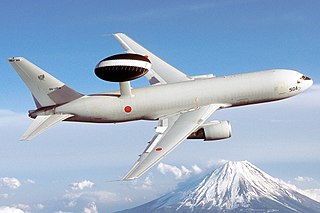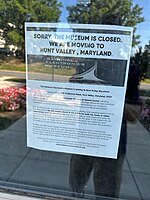
The Northrop Grumman E-8 Joint Surveillance Target Attack Radar System is a retired United States Air Force (USAF) airborne ground surveillance, battle management and command and control aircraft. It tracks ground vehicles and some aircraft, collects imagery, and relays tactical pictures to ground and air theater commanders. The aircraft was operated by both active duty USAF and Air National Guard units and also carried specially trained U.S. Army personnel as additional flight crew.

The RQ-3 DarkStar is an unmanned aerial vehicle (UAV). Its first flight was on March 29, 1996. The Department of Defense terminated DarkStar in January 1999, after determining the UAV was not aerodynamically stable and was not meeting cost and performance objectives.

The Northrop Grumman E-2 Hawkeye is an American all-weather, carrier-capable tactical airborne early warning (AEW) aircraft. This twin-turboprop aircraft was designed and developed during the late 1950s and early 1960s by the Grumman Aircraft Company for the United States Navy as a replacement for the earlier, piston-engined E-1 Tracer, which was rapidly becoming obsolete. The aircraft's performance has been upgraded with the E-2B and E-2C versions, where most of the changes were made to the radar and radio communications due to advances in electronic integrated circuits and other electronics. The fourth major version of the Hawkeye is the E-2D, which first flew in 2007. The E-2 was the first aircraft designed specifically for AEW, as opposed to a modification of an existing airframe, such as the Boeing E-3 Sentry. Variants of the Hawkeye have been in continuous production since 1960, giving it the longest production run of any carrier-based aircraft.

Linthicum is a census-designated place (CDP) and unincorporated community in Anne Arundel County, Maryland, United States. The population was 10,324 at the 2010 census. It is located directly north of Baltimore–Washington International Thurgood Marshall Airport (BWI).

Sperry Corporation was a major American equipment and electronics company whose existence spanned more than seven decades of the 20th century. Sperry ceased to exist in 1986 following a prolonged hostile takeover bid engineered by Burroughs Corporation, which merged the combined operation under the new name Unisys. Some of Sperry's former divisions became part of Honeywell, Lockheed Martin, Raytheon Technologies, and Northrop Grumman.

Northrop Grumman Corporation is an American multinational aerospace and defense technology company. With 95,000 employees and an annual revenue in excess of $30 billion, it is one of the world's largest weapons manufacturers and military technology providers. The firm ranked No. 101 on the 2022 Fortune 500 list of America's largest corporations.

The Westinghouse Electric Corporation was an American manufacturing company founded in 1886 by George Westinghouse. It was originally named "Westinghouse Electric & Manufacturing Company" and was renamed "Westinghouse Electric Corporation" in 1945. The company acquired the CBS television network in 1995 and was renamed "CBS Corporation" until being acquired by Viacom in 1999, a merger completed in April 2000. The CBS Corporation name was later reused for one of the two companies resulting from the split of Viacom in 2005.

Simon "Si" Ramo was an American engineer, businessman, and author. He led development of microwave and missile technology and is sometimes known as the father of the intercontinental ballistic missile (ICBM). He also developed General Electric's electron microscope. He played prominent roles in the formation of two Fortune 500 companies, Ramo-Wooldridge and Bunker Ramo Corporation.
Northrop Grumman Electronic Systems (NGES) was a business segment of Northrop Grumman from 1996 to 2015 until a reorganization on January 1, 2016, merged other Northrop Grumman businesses into NGES to form a new segment called Mission Systems. NGES had originally been created by Northrop Grumman's acquisition of Westinghouse Electronic Systems Group in 1996. The Electronic Systems sector was a designer, developer, and manufacturer of a wide variety of advanced defense electronics and systems. The division had 120 locations worldwide, including 72 international offices, and approximately 24,000 employees; accounting for 20% of company sales in 2005.

The AN/APG-68 radar is a long range Pulse-doppler radar designed by Westinghouse to replace AN/APG-66 radar in the F-16 Fighting Falcon. After years of Service, AN/APG-68 radar currently being replaced on US Air Force F-16C/D Block 40/42 and 50/52 by the latest generation AN/APG-83 AESA radar.

A passive electronically scanned array (PESA), also known as passive phased array, is an antenna in which the beam of radio waves can be electronically steered to point in different directions, in which all the antenna elements are connected to a single transmitter and/or receiver. The largest use of phased arrays is in radars. Most phased array radars in the world are PESA. The civilian microwave landing system uses PESA transmit-only arrays.
Lockheed Martin Rotary and Mission Systems (LM RMS), is a Lockheed Martin business segment headquartered in Washington, D.C. Until October 2008, RMS was headquartered in Moorestown Township, New Jersey, a suburb of Philadelphia; Moorestown remains one of the largest sites in the business unit and is where many of the unit's top executives have their offices.

Also called the "Day of Playful Invention", Robot fest "is an annual event for anyone interested in the creative use of technology" to promote science, technology, engineering and mathematics (STEM). It takes place at the National Electronics Museum in Linthicum, Maryland and entry is donation based.

The Boeing E-767 is an Airborne Warning and Control System (AWACS) aircraft that was designed in response to the Japan Air Self-Defense Force's requirements. It is essentially the Boeing E-3 Sentry's surveillance radar and air control system installed on a Boeing 767-200.
Anaren, Inc. provides high-frequency microwave microelectronics, components, and assemblies for wireless, aerospace, and defense electronics applications.
F. Suzanne Jenniches is an American engineer who served from April 2, 2003, to 2010 as the vice president and general manager of Government Systems Division of Northrop Grumman Corp.'s Electronic Systems sector. She holds a patent for laser soldering. She was the only woman to take engineering evening classes at Johns Hopkins University in the 1970s. She was among the first women to do so at that University. She was both the first female engineer and, therefore, the first intern at Westinghouse Electric Company. She is one of the first female leaders at Northrop Grumman, and considered a pioneer by the Society of Women Engineers.
Northrop Grumman Innovation Systems (NGIS) was a sector of Northrop Grumman from 2018 through 2019. It was formed from Orbital ATK Inc. a company which resulted from the merger of Orbital Sciences Corporation and parts of Alliant Techsystems in 2015. Orbital ATK was purchased by Northrop Grumman in 2018. Northrop Grumman Innovation Systems designed, built, and delivered space, defense, and aviation-related systems to customers around the world both as a prime contractor and as a merchant supplier. It had a workforce of approximately 12,000 employees dedicated to aerospace and defense including about 4,000 engineers and scientists; 7,000 manufacturing and operations specialists; and 1,000 management and administration personnel. With Northrop Grumman's reorganization of its divisions effective January 1, 2020, NGIS was split, with most of the sector merging with other Northrop Grumman businesses into a new Space Systems sector.
The BWI Business District is a neighborhood and business district in Linthicum and Hanover that features over 11,000 hotel rooms and numerous office parks and shopping centers. As the name suggests, the business district is benefited by nearby Baltimore/Washington International Airport.
Roberto Sabatini is an Italian-Australian research engineer and academic specializing in aerospace and defense systems. Currently, he is a full professor at Khalifa University of Science and Technology (UAE) and honorary professor at RMIT University (Australia). Sabatini holds or has held visiting and consulting appointments at a number of institutions, including: Polytechnic University of Turin (Italy); Chosun University ; Durban University of Technology/Space Science Center ; the UAE Space Agency; and the Korea Aerospace Research Institute. Additionally, Sabatini is a member of the Board of Governors of the IEEE Aerospace and Electronic Systems Society (AESS), Chair of the IEEE AESS Avionics Systems Panel, and Distinguished Lecturer of the IEEE AESS

Space Park is an aerospace engineering campus occupying over 100 acres in Redondo Beach, California, since 1961, expanding in 1968 to a nearly adjacent 90 acres in Manhattan Beach.

















